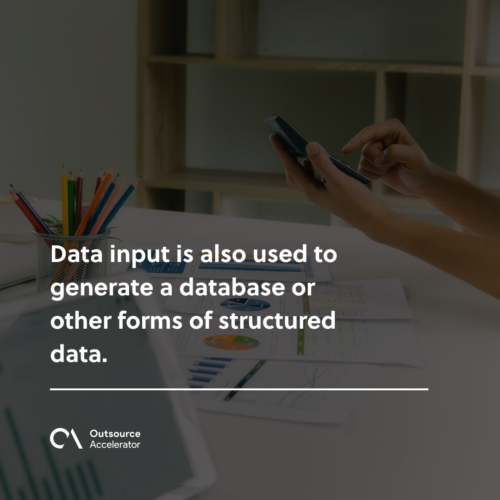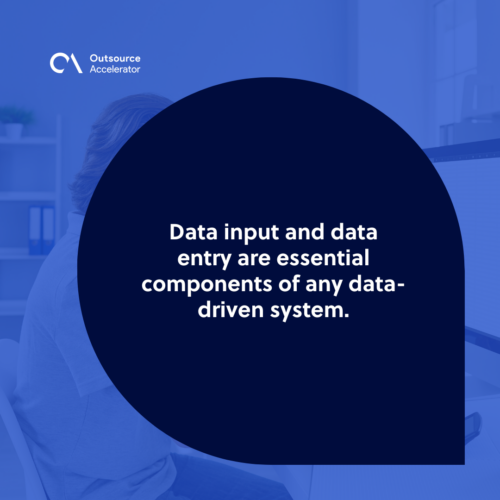Data input vs. Data entry: A side-by-side comparison

The business world is full of terms that appear to have nearly identical meanings to others.
Industry jargon is used to describe several sorts of company activities. For instance, outsourcing and offshoring are sometimes used interchangeably, yet they have different meanings.
Using one word for the other may not make a significant difference. Ultimately, you might attempt to deliver an unclear message if you don’t compare and contrast the meaning of two words.
Understanding the distinctions between terminologies like ‘marketing’ and ‘advertising’ or ‘strategy’ and ‘tactics’ will help you make better decisions and be successful. Further, organizations must understand the differences between business terms.
This article will discuss a side-by-side comparison of data input and data entry to help you use the words correctly.
What is data input?
Data input refers to any information delivered to a computer or software application.
Because the provided information is also considered data, supplying information to the computer is also known as data input. This action enables the computer to perform its intended function and provide an output.
For instance, the employee code you enter into the computer coupled with a thumb imprint is your employer’s attendance monitoring system’s input — which becomes the output = your attendance presence.
Data input is also used to generate a database or other forms of structured data. The word or phrase you type into your search engine’s text field is the data input that will process and provide a result for you.

What is data entry?
Data entry is the process of entering any type of data into an online device, such as a computer or other electronic device. It aids in the transformation of raw data into valuable information.
For instance, entering data into spreadsheets allows you to integrate these sheets and applications to get more comprehensive conclusions and actionable data.
Before, businesses utilized pen and paper to enter data, but this has now transitioned to data entry into computers.
Purpose of data input and data entry
Companies collect a significant quantity of data on a daily basis. Data quality is crucial to ensuring that data is accurate and reliable. When reliable data is not entered into an organized electronic system, it causes the following pitfalls:
- Revenue loss
- Unrecognized competitive advantage
- Missing business opportunities
- Other data-related problems
More specifically, let’s discuss the importance of both data processes in separate views:
What is the purpose of data input?
Data input serves more than one purpose:
- When you withdraw money from an ATM, you enter the pin and the amount—these are what the ATM software requires to execute the transaction. In that scenario, the pin you entered to access your account in the machine and release the money, is the input.
- Another example is when a registrar wants to access your student record, she will enter a key into the program, which may be your ID number. Then the computer will bring up your data. In this scenario, the ID number is used as the input.
Overall, data input is the one that triggers the action in the computer or other digital systems.
What is the purpose of data entry?
Data entry commonly:
- Makes data available to computer systems
- Is a crucial phase in data management
- A system cannot store or process information without data entry methods
Data input and data entry source
Let’s find out what the data input and data entry sources are:
What is data input source?
Data input source can be:
- Keyboard
- Input device
- Scanner
- Automated machine
Moreover, data input sources can be used to keep customer information, financial records, and other data types.
What is data entry source?
An example of a data entry source is a piece of paper with some information. Writings on cave walls and stone tablets can also be knowledge sources that must be accessible to future generations. Software programs will then be used to transcribe these sets of data.
Because of its anticipated future usage, a data analyst must move the material from its present storage medium to a medium where it can be easily retrieved.
Both data sources are essential for ensuring the accuracy and integrity of data. Without these, a system could not store and process data.
Tools used in data input and data entry
Because data input does not necessarily mean inputting large amounts of data, the tools utilized for this might be more varied.
Data entry requires the most basic equipment for accessing software. The destination program, where information must be sent, can technically be accessed using other devices, such as smartphones and tablets.
Data input vs. Data entry: Using the right term at the right time
Data input and data entry are essential components of any data-driven system.

However, using the right term at the right time is vital. For instance, if someone is talking about entering data into a device or machine, they should use “data input” instead of “data entry.”
It helps ensure everyone is on the same page and that the conversation is clear and concise.







 Independent
Independent




